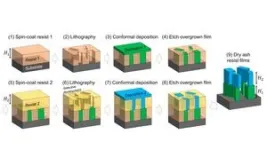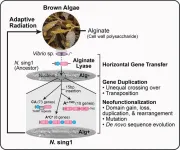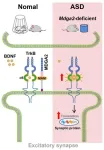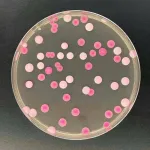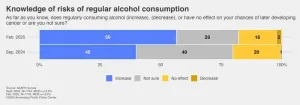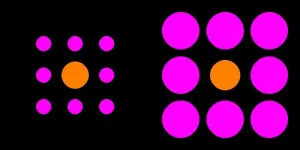(Press-News.org) Almost a decade ago, Harvard engineers unveiled the world’s first visible-spectrum metasurfaces – ultra-thin, flat devices patterned with nanoscale structures that could precisely control the behavior of light. A powerful alternative to traditional, bulky optical components, metasurfaces today enable compact, lightweight, multifunctional applications ranging from imaging systems and augmented reality to spectroscopy and communications.
Now, researchers in the Harvard John A. Paulson School of Engineering and Applied Sciences (SEAS) are doubling down, literally, on metasurface technology by creating a bilayer metasurface, made of not one, but two stacked layers of titanium dioxide nanostructures. Under a microscope, the new device looks like a dense array of stepped skyscrapers.
The research is published in Nature Communications.
“This is a feat of nanotechnology at the highest level,” said senior author Federico Capasso, the Robert L. Wallace Professor of Applied Physics and Vinton Hayes Senior Research Fellow in Electrical Engineering at SEAS. “It opens up a new way to structure light, in which we can engineer all its aspects such as wavelength, phase and polarization in an unprecedented manner…It signifies a new avenue for metasurfaces that so far has been just scratching the surface.”
For centuries, optical systems have relied on bulky, curved lenses made of glass or plastic to bend and focus light. The SEAS-led metasurface revolution of the last decade has produced flat, ultra-thin structures patterned with millions of tiny elements that can manipulate light with nanometer precision. A striking example technology is the metalens: Unlike conventional lenses, metalenses can be fabricated with existing semiconductor manufacturing, making possible compact, integrated optical systems in devices like smartphones, cameras, and augmented reality displays.
After Capasso’s team reported their first working metalens that can bend visible light, they worked with Harvard’s Office of Technology Development to license the technology and start a company, Metalenz. They’ve since demonstrated a host of potential applications, including an endoscope, an artificial eye, and a telescope lens.
But the single-layer nanostructure design Capasso’s team invented has been in some ways limiting. For example, previous metasurfaces put specific requirements on the manipulation of light’s polarization – that is, the orientation of the light waves – in order to control the light’s behavior.
“Many people had investigated the theoretical possibility of a bilayer metasurface, but the real bottleneck was the fabrication,” said Alfonso Palmieri, graduate student and co-lead author of the study. With this breakthrough, Palmieri explained, one could imagine new kinds of multifunctional optical devices – for example, a system that projects one image from one side and a completely different image from the other.
Using the facilities of the Center for Nanoscale Systems at Harvard, the team that included former postdoctoral researchers Ahmed Dorrah and Joon-Suh Park came up with a fabrication process for freestanding, sturdy structures of two metasurfaces that hold strongly together but do not affect each other chemically. While such multi-level patterning has been common in the silicon semiconductor world, it had not been as well explored in optics and metaoptics.
To demonstrate the power of their device, the team devised an experiment in which they used their bilayer metalens to act on polarized light in the same way that a complicated system of waveplates and mirrors does.
In future experiments, the team could expand into even more layers to exert control over other aspects of light, such as extreme broadband operation with high efficiency across the entire visible and near infrared spectrum, opening the door to even more sophisticated light-based functionalities.
The research was supported by several federal funding sources, including the Office of Naval Research under grant No. N00014-20-1-2450, and from the Air Force Office of Scientific Research under grant No.s FA9550-21-1-0312 and FA9550-22-1-0243. The devices were made at the Harvard University Center for Nanoscale Systems, part of the National Nanotechnology Coordinated Infrastructure Network, which is supported by the National Science Foundation under NSF award No. ECCS-2025158.
Staff acknowledgments: Stephan Kraemer supported the focused ion beam process, and Mac Hathaway supported the atomic layer deposition process.
END
Doubling down on metasurfaces
Bilayer device can control many forms of polarized light
2025-04-01
ELSE PRESS RELEASES FROM THIS DATE:
New Cedars-Sinai study shows how specialized diet can improve gut disorders
2025-04-01
A new study from Cedars-Sinai examined whether a specialized diet could improve symptoms of gastrointestinal disorders linked to an imbalance in gut microbiota.
The research tested the elemental diet’s effectiveness and explored whether improving its unappealing taste— a major barrier—could help patients adhere to the diet’s stringent protocol. The investigators’ findings were published in the peer-reviewed journal Clinical Gastroenterology and Hepatology.
The elemental diet is a special low-fat liquid formulation ...
Making moves and hitting the breaks: Owl journeys surprise researchers in western Montana
2025-04-01
Researchers tracked 89 Northern Saw Whet Owls (Aegolius acadicus) along a migration corridor in Western Montana, underscoring the efficacy of telemetry studies for detailed investigations into the movements of birds. Their paper, “Migration and Roosting Behavior of Northern Saw-whet Owls (Aegolius acadicus) During Fall Migration in Western Montana,” was published in the Journal of Raptor Research. The research team was surprised to discover that owls demonstrated stopover behavior, meaning pauses along migration for resting and refueling, as well as notable individual ...
PKU Scientists simulate the origin and evolution of the North Atlantic Oscillation
2025-04-01
Peking University, March 31, 2025: A simulation on the origin and evolution of North Atlantic Oscillation (NAO) has been conducted by a PKU research team led by Nie Ji, Associate Professor of School of Physics, and Hu Yongyun, Dean of Institute of Ocean Research, along with a research team from National Natural Science Foundation of China. Their study, recently published in Nature Communications, reveals the coherent relationship between NAO and the evolution of continents, mountains and oceans.
Why It Matters:
NAO plays a critical role in shaping climate patterns, affecting temperature, precipitation, and storms across regions like Europe, China, ...
ICRAFT breakthrough: Unlocking A20’s dual role in cancer immunotherapy
2025-04-01
Peking University, March 31, 2025: Professor Zeng Zexian’s team from the Center for Quantitative Biology at the Peking University Academy for Advanced Interdisciplinary Studies, in collaboration with the Peking University-Tsinghua University Joint Center for Life Sciences, has developed ICRAFT, an innovative computational platform for identifying cancer immunotherapy targets. Their study has been published in Immunity, an immunology research journal.
Why It Matters:
·There is an urgent need for precision immunotherapy strategies that simultaneously target both ...
How VR technology is changing the game for Alzheimer’s disease
2025-04-01
BOSTON - April 1, 2025 - Most people donning virtual reality (VR) goggles are seeking the thrill of being immersed in a fictitious video game world. But some are donning them for an entirely different experience: to help researchers identify those most at risk of developing Alzheimer’s disease.
“We know that early detection of Alzheimer’s disease and other dementias can have a significant impact on the quality of life of the affected persons, through deployment of lifestyle changes and medications ...
A borrowed bacterial gene allowed some marine diatoms to live on a seaweed diet
2025-04-01
A group of diatom species belonging to the Nitzschia genus, gave up on photosynthesis and now get their carbon straight from their environment, thanks to a bacterial gene picked up by an ancestor. Gregory Jedd of Temasek Life Sciences Laboratory, Singapore, and colleagues report these findings in a new study published April 1st in the open-access journal PLOS Biology.
Unlike most diatoms, which perform photosynthesis to generate carbon compounds, some members of the genus Nitzschia have no chlorophyll and instead ...
Balance between two competing nerve proteins deters symptoms of autism in mice
2025-04-01
In mice, autism symptoms arise when a certain pair of competing nerve proteins falls out of equilibrium, according to a study published April 1st in the open-access journal PLOS Biology by Dongdong Zhao of Wenzhou Medical University, China, Yun-wu Zhang of Xiamen University, China, and colleagues.
Approximately 1% of the world population is considered to have Autism Spectrum Disorder (ASD), exhibiting a series of social and cognitive symptoms. Previous research has linked certain genetic factors to ASD, including many associated ...
Use of antifungals in agriculture may increase resistance in an infectious yeast
2025-04-01
Genomic changes in the infectious yeast Candida tropicalis may play a role in its resistance to antifungals, according to a study published on April 1st in the open-access journal, PLOS Biology by Guanghua Huang at Fudan University, China, and colleagues. These genomic changes can be brought on by a common antifungal, TBZ. The study demonstrates that the use of TBZ in agriculture may contribute to the increasing problem of antifungal resistance.
C. tropicalis is one of the most common fungi to infect humans, ...
Awareness grows of cancer risk from alcohol consumption, survey finds
2025-04-01
PHILADELPHIA – Public awareness of the link between drinking alcohol and an elevated risk of cancer has grown since last fall, with more than half of Americans now saying that regularly consuming alcohol increases your chances of later developing cancer, according to a survey by the Annenberg Public Policy Center (APPC) of the University of Pennsylvania.
In the survey, conducted Jan. 30-Feb. 10, 2025, with over 1,700 U.S. adults, 56% say the regular consumption of alcohol increases your chances of later developing cancer, up from 40% in an Annenberg survey in September 2024. The percentage of those who say alcohol ...
The experts that can outsmart optical illusions
2025-04-01
Medical imaging experts are adept at solving common optical illusions, according to research from four UK universities, including the University of East Anglia.
The correct analysis of medical images from scans, such as MRI, is critical for diagnosing cancer and many other conditions.
A new study published today shows that people who do this professionally are also more accurate at judging the size of objects in common optical illusions.
In other words, medical imaging experts also literally see better in everyday life!
The research is also the ...
LAST 30 PRESS RELEASES:
Norbert Holtkamp appointed director of Fermi National Accelerator Laboratory
New agentic AI platform accelerates advanced optics design
Biologists discover neurons use physical signals — not electricity — to stabilize communication
Researchers discover that a hormone can access the brain by hitchhiking
University of Oklahoma researcher awarded funding to pursue AI-powered material design
Exploring how the visual system recovers following injury
Support for parents with infants at pediatric check-ups leads to better reading and math skills in elementary school
Kids’ behavioral health is a growing share of family health costs
Day & night: Cancer disrupts the brain’s natural rhythm
COVID-19 vaccination significantly reduces risk to pregnant women and baby
The role of vaccination in maternal and perinatal outcomes associated with COVID-19 in pregnancy
Mayo Clinic smartwatch system helps parents shorten and defuse children's severe tantrums early
Behavioral health spending spikes to 40% of all children’s health expenditures, nearly doubling in a decade
Digital cognitive behavioral treatment for generalized anxiety disorder
Expenditures for pediatric behavioral health care over time and estimated family financial burden
Air conditioning in nursing homes and mortality during extreme heat
The Alps to lose a record number of glaciers in the next decade
What makes a good proton conductor?
New science reporting guide published for journalists in Bulgaria
New international study reveals major survival gaps among children with cancer
New science reporting guide published for journalists in Turkey
Scientists develop a smarter mRNA therapy that knows which cells to target
Neuroanatomy-informed brain–machine hybrid intelligence for robust acoustic target detection
Eight SwRI hydrogen projects funded by ENERGYWERX
The Lundquist Institute and its start-up company Vitalex Biosciences Announces Strategic Advancement of Second-Generation fungal Vaccine VXV-01 through Phase 1 Trials under $40 Million Competitive Con
Fine particles in pollution are associated with early signs of autoimmune disease
Review article | Towards a Global Ground-Based Earth Observatory (GGBEO): Leveraging existing systems and networks
Penn and UMich create world’s smallest programmable, autonomous robots
Cleveland researchers launch first major study to address ‘hidden performance killer’ in athletes
To connect across politics, try saying what you oppose
[Press-News.org] Doubling down on metasurfacesBilayer device can control many forms of polarized light


